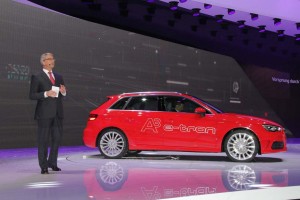Fresh off its strongest year ever, Audi AG is taking aim at German rival BMW AG and promising to become the world’s largest luxury automotive brand.
The maker is planning to invest more than $14 billion through 2015 to support its ambitious goals, funding a product program that will cover the increasing breadth of the luxury segment, from the small A3 hatchback to an assortment of new crossover-vehicles, such as the planned Audi Q6, said CEO Rupert Stadler. It also is investing in a number of new assembly plants, including one planned for Mexico.
“There are years in which to harvest in our industry and there are years in which you sow,” said Stadler at Audi headquarters in Ingollstadt, Germany. While the cost will be significant, the payoff should come by 2020, when the executive added, “we are preparing to (sell) two million cars annually.”
A subsidiary of Volkswagen AG, Audi already has been running ahead of its growth targets, selling 1.46 million vehicles in 2012 and shooting for 1.5 million this year – a goal it originally had set for 2015.
Audi long lagged its German luxury rivals BMW and the Mercedes-Benz unit of Daimler AG. One of the key reasons was its weak performance in the U.S. market, largely the result of a safety scandal dating back to the late 1980s that, it turns out, the maker was eventually cleared of. Audi is still a weak fourth in the States, also struggling to catch up to Toyota’s Lexus, but it has been building significant momentum in what remains the world’s largest luxury market.
And It could close some of the gap when a new assembly plant opens in Mexico. The facility is expected to serve markets around the world but should nonetheless help Audi’s drive in North America. Meanwhile, the maker also is adding plants in Hungary and in China, where it is already the largest luxury brand.
“In the coming year, Audi will for the first time build more cars outside Germany than within,” Stadler said. He gave direct hints that further overseas production options are under study, including plants in Russia and Brazil.
But factories can only deliver the products consumers want and Audi plans to invest $14.3 billion in new vehicles and the plants to build them, stressed Stadler. Among the key models in the pipeline are variants of the all-new Audi A3 Sportback and an array of new crossover-utility vehicles. These include sport counterparts to the current Q3, Q5 and Q7 models, to be called the Q2, Q4 and Q6. They will directly target BMW offerings such as the coupe-crossover X6 line.
The wide range of new offerings underscores the transformation of the global luxury car market. There was a time when makers like Audi, BMW and Mercedes could compete with a handful of product lines, primarily sedans small, medium and large, as well as a sports car and perhaps a single SUV. Today, the high-line segment is awash in product proliferation, an alphanumeric soup in which makers try to fill every possible open niche.
The A3 is expected to become particularly important, reflecting the general downsizing by many luxury buyers as fuel costs keep rising. But Audi has recognized that one size won’t fit all and the Sportback to be offered in most markets will also be paired with other variants, including a sedan for hatchback-resistant U.S. buyers.
The A3 also will introduce Audi’s first plug-in hybrid, the A3 e-Tron debuting at last week’s Geneva Motor Show. (For a closer look at the A3 Sportback e-Tron, Click Here.)
The A3 will be the first of the brand’s models to offer an extended-range electric drivetrain, capable of about 30 miles on pure battery power before the gasoline engine kicks in, and “We plan to add one more (plug-in) annually per year,” Heinz Hollerweger, Audi’s technical chief, said during an interview following the Geneva debut of the e-Tron.
There is a downside to Audi’s ambitions, net profits falling 2% in 2012%, to 4.35 billion Euros, or $5.7 billion, largely due to its ramped-up investment program. The company’s operating margins also dipped to a still-strong 11%, and ahead of the 8% to 10% target for the next two years.
Revenues rose last year to 48.8 billion Euros, or $63.5 billion, on the overall increase in sales.
Stadler’s far-reaching goals will be critical not just for the Audi brand but for Volkswagen AG, analysts note, as the luxury subsidiary has become the parent company’s single largest revenue driver – and if it can hit its own sales target, Audi could deliver the momentum VWAG needs to reach its own goal of toppling Toyota to become the world’s best-selling automaker overall before decade’s end.


Being the largest volume auto seller doesn’t make your product the best, it just makes it popular. Parent company VW is on a suicide mission IMO, to be #1 in sales volume and it may come at a very expensive price which has nothing to do with the financial cost to buy this title.